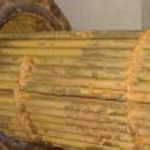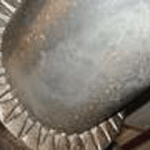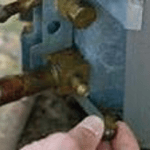Insufficient/Slow Cooling
Chiller frequently unloading (stop-start); Compressor not starting
Corroded parts of condenser – face plate, tubes

Scale in condenser pipes
Condensation on chilled water pipes

No insulation for chilled water pipe

Refrigerant Leakage
Probable causes for the defect
- Pipe surface become cold if insulation is inadequate.
- Insulation is damaged during careless maintenance of the equipments.
- For positively pressured chillers, refrigerant leaks through joints (at gasket, piping, monitoring socket etc), which may be opened for maintenance and later not tightened.
- No checking for system leakage and remedial measures taken.
Design
Design chiller plants according to the required cooling demand, with provisions for future expansions as per SS 553 and in compliance with the requirements of SS 554. (See also AS 1668.2, ISO 16814).
Comply with air conditioning plant optimisation strategies (e.g. high-efficiency chillers, aggressive condenser water reset, medium temperature chilled water loop, chilled water VFD pumping, etc.) as per SS 564-1.
Use refrigerants with zero ozone depleting potential (ODP) or global warming potential (GWP) of less than 100 [1].
Recommend installation of leak detection system in critical areas of plant rooms.
Ensure minimum environmental standards in accordance with the Code for Environmental Sustainability of Buildings. For industrial facilities, ensure compliance with NEA’s Minimum Energy Efficiency Standards (MEES).
Construction
Conduct proper commissioning of chiller plant and set reasonable points.
Perform post installation monitoring of the installed instrument’s performance through the BMS (building automation system) or EMS (energy measurement system). (SS 652: F.6.1.2.1).
Maintenance
Set up appropriate cut-in and cut-out temperatures in chiller to avoid frequent unloading (SS 652: F.11.1.1.1).
Inspect evaporator tubes for excessive oil, dirt or frost; check operating condition of expansion valve; check condenser tubes for air, dirt, scale, and sludge, and clean/purge if necessary.
Check condenser water supply and cooling tower efficiency. Inspect overload relay, and the condition of high pressure and low pressure cut-outs. (SS 652: F.11.1.1.2).
Conduct monthly inspection on refrigerant level to avoid low pressure cut-outs of chiller in accordance ANSI/ASHRAE/ ACCA Standard 180. (SS 652: F.11.1.1.3) and compare with the standard list of normal acceptable operating range to ensure the best possible performance and efficiency of a chiller.